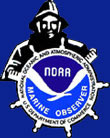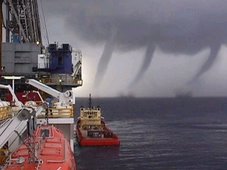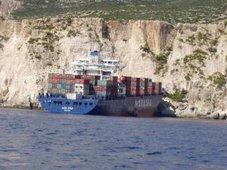 News from the National Weather Service that is sure to get (geo)data-wonks excited…
News from the National Weather Service that is sure to get (geo)data-wonks excited… From the National Oceanographic & Atmospheric Adminstration (parent agency of NWS), the current means of tracking severe weather events is done in the following manner:
…The NWS currently issues and disseminates warnings for tornado, severe thunderstorm, flood and marine hazards using geopolitical boundaries.
As of 1 October 2007, this system will change to something new:
Storm-Based Warnings (threat-based polygon warnings), are essential to effectively warn for severe weather. Storm-Based Warnings show the specific meteorological or hydrological threat area and are not restricted to geopolitical boundaries. By focusing on the true threat area, warning polygons will improve NWS warning accuracy and quality…
You may want to ask Umibot “what’s the big deal?” Some graphics from the Storm-Based Warnings (NB: press release to follow on 10/01/07) illustrate this:


On the left, the county is used as the unit of measure–this means if a predicted storm path touches a county boundary, the entire county will receive an alert. This is especially cumbersome in some Western states, where counties can be extremely large. Deploying emergency resources (first responders, food, supplies, etc…) and alarming the public when not necessary could prove and expensive proposition.
The image on the right highlights the new approach: “threat-based polygons” might sound menacing, they are no different from what the NWS currently uses with a key exception: the granularity has changed such that the unit of measure is now the municipal boundary.
From UMI’s perspective, what is interesting to note is that NOAA prediction accuracy did not drive the Storm-Based Warnings program–there are meteorological (and related) advances that help officials understand patterns of severe weather, and that is independent from presenting those data. Because prediction science has become more accurate, a smaller unit of measure (ie, municpal area) can be used. From this perspective one could say predictions were ‘hiding’ behind the larger unit of measure (ie, county).
Umibot likes these kinds of stories because they play directly into his (or her?) sweet spot–the design of data. And this was the focus of a talk Ian gave last year on the very subject.
The analogy for local search is clear–data should drive the use case of an application. If one is going to offer an application that allows for (say) mobile search, will a user have the granularity that is needed to have a meaningful experience? An example here is “restaurants in San Francisco”–mobile means you are, well, mobile, on the go, and a city is (probably) not a meaningful geo-constraint. Something more granular, like a 2 mile radius (if the device is location-aware), cross street, or neighborhood will likely be more satisfying.
Maritime Notes:DHS OIG – targeting oceangoing cargo containers
The Department of Homeland Security (DHS) Office of the Inspector General (OIG) issued an unclassified summary of its investigation into targeting of oceangoing cargo containers by the US Customs and Border Protection (CBP). Although it identified improvements since its earlier investigation, the OIG found that CBP is not consistently monitoring entry data for all shipments, resulting in some high-risk containers being allowed to leave ports without mandatory examinations. Furthermore, flaws in the Cargo Enforcement Reporting and Tracking System may result in improper container releases and CBP still has not automated its integration of examination findings into ATS. Finally, some ports need to improve their controls over high-security bolt seals. OIG-07-72 (9/18/07).
Hearing re new radiation detection monitors
The Subcommittee on Oversight and Investigations of the House Committee on Energy & Commerce conducted a hearing on the Status of the Federal Government’s Assessment of New Radiation Detection Monitors. These devices, known as advanced spectroscopic portal (ASP) monitors, are intended to reduce the frequency of false positive reports by differentiating between harmless and harmful radiation sources and to make it more difficult for terrorists to mask radiation signatures. The Government Accountability Office (GAO) submitted testimony showing that the agency used biased test methods, allowing ASP contractors to conduct preliminary runs so that the monitors could be adjusted for specific test material. The GAO also submitted a Timeline of the ASP program and a Briefing regarding its concerns about going forward with this procurement. Mr. Paul A. Schneider, DHS Undersecretary for Management, testified that additional independent tests of the ASP monitors have been ordered. Mr. Vayl S. Oxford, Director, Domestic Nuclear Detection Office (DNDO), stated that his agency is committed to rigorously testing and evaluating emerging technologies. Mr. David Huizenga, Department of Energy, stated that additional analysis and field testing will be conducted before large-scale acquisition of ASP monitors begins. Why does one get the impression that DNDO got caught with its hand in the cookie jar? (9/18/07).
From Cargolaw
Jack-up rig barge Lisa A, being used to work on a wind farm development between Scotland and England, was evacuated amidst fears it would overturn in gale force winds on the night of 16 Sept. During the operation, two of the vessel's legs bent, causing it to list over 30 degrees. Coast Guard teams and helicopters from both sides of the Solway Firth took part in the rescue. From our Correspondent A. L. Griffiths (Tues. Sept. 18 2007)
RS


































































































![Validate my RSS feed [Valid RSS]](valid-rss.png)